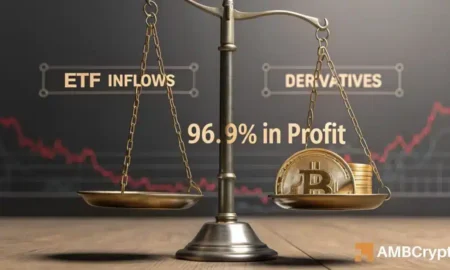Ethereum’s Short Squeeze: Analyzing the Market Dynamics Behind the $500 Million Liquidation
Ethereum’s recent price surge above $2,670 has captured the attention of traders and analysts alike, triggering a massive short squeeze that has cost short sellers an astounding $500 million. This event marks one of the largest liquidations in the cryptocurrency market in recent times and underscores the volatility that characterizes Ethereum and the broader crypto landscape.
What Triggered the Short Squeeze?
The short squeeze was primarily fueled by an unexpected rally in Ethereum’s price, catching many traders off-guard. Many were expecting further downside, leading them to enter leveraged short positions. However, as ETH rebounded and began to rise above the critical price level of $2,670, the market dynamics shifted dramatically. Data from CryptoQuant indicated a significant delta in short liquidations on Binance, highlighting a concentration of bearish bets that ultimately fueled the price rally.
Traders who had entered their positions anticipating a decline faced margin calls, which forced them to buy back ETH at elevated prices to cover their short positions. This chain reaction not only propelled Ethereum’s price upward but also shifted market sentiment from bearish to bullish almost instantaneously. As a result, the funding rates turned positive, indicating a reversal in sentiment and a robust unwinding of bearish leverage.
Rising Ethereum Inflows: Implications for Volatility
Following the massive short squeeze, Ethereum has witnessed a surge in inflows to derivative exchanges, with some transactions exceeding 30,000 ETH. This rise began around June 13 and suggests quick repositioning among traders who are eager to capitalize on the sudden shift in market dynamics. While some traders might be hedging their spot exposure post-squeeze, the sheer volume of inflows points to a growing interest in short-selling.
The increased influx of ETH into derivatives signifies a potentially precarious market landscape. If Ethereum’s price begins to lose momentum, this heightened short-selling interest could amplify bearish pressure in the market, leading to the risk of another sharp unwind similar to what was recently experienced. Traders need to remain vigilant as the market conditions evolve.
Positive Funding Rates: A Bearish Signal or Signs of Recovery?
Post-rebound, Ethereum’s funding rates turned positive, which is often interpreted as a sign of growing bullish sentiment in the market. During the preceding rally, open interest surged but subsequently fell sharply due to the liquidations that occurred. However, it has since stabilized around $15.4 billion. The increase in funding rates indicates that traders are once again willing to pay to hold long positions, emphasizing renewed optimism.
Positive funding rates typically suggest that a larger number of traders believe the price will continue to rise, providing a layer of support in the market. However, it’s crucial to consider that such conditions can also invite new short-selling pressures if market sentiment flips again. This inherent volatility makes Ethereum a noteworthy asset for both long-term holders and speculative traders.
Market Sentiment: A Double-Edged Sword
The recent market dynamics have introduced a complex emotional landscape. While some traders are riding the wave of bullish sentiment, others are wary of potential volatility indicated by rising short positions. The market sentiment can shift rapidly, especially in a space like Ethereum where significant events—such as announcements, regulatory news, or macroeconomic changes—can abruptly alter price trajectories.
Given the rapid shifts in trader sentiment, it’s essential for market participants to adopt a flexible trading strategy. Whether one is looking for short-term gains or long-term exposure, understanding these dynamics can help in making more informed decisions. As sentiment oscillates, new opportunities and risks arise, making knowledge and adaptation key to effective trading.
Looking Ahead: What’s Next for Ethereum?
As Ethereum navigates through this volatile phase, traders and analysts are closely monitoring developments that could impact market dynamics further. One major aspect to consider is the trend of liquidations driven by excessive leverage in both long and short positions. If traders do not adequately manage their risk, sudden market reversals could lead to significant losses.
Opportunity also lies ahead for those who can accurately predict Ethereum’s next moves. As the market reacts to rising inflows, positive funding rates, and the volatility of short positions, traders must remain informed and agile. By staying current with market conditions and adjusting strategies accordingly, they can capitalize on potential opportunities that may arise.
Conclusion: The Volatile Nature of Ethereum and the Importance of Strategy
The recent surge in Ethereum’s price and subsequent short squeeze serves as a potent reminder of the cryptocurrency market’s volatility and unpredictability. The $500 million liquidation illustrates the risks associated with excessive leverage, both for short and long positions. As Ethereum enters a new phase of trading characterized by rising inflows and positive funding rates, it’s crucial for traders to approach the market with a balanced perspective.
Understanding the factors behind the short squeeze, monitoring funding rates, and adjusting trading strategies accordingly are essential for navigating this fast-paced environment. With the potential for further volatility on the horizon, traders who remain well-informed will be better positioned to leverage the opportunities presented by the ever-changing landscape of Ethereum and the broader cryptocurrency market.
















